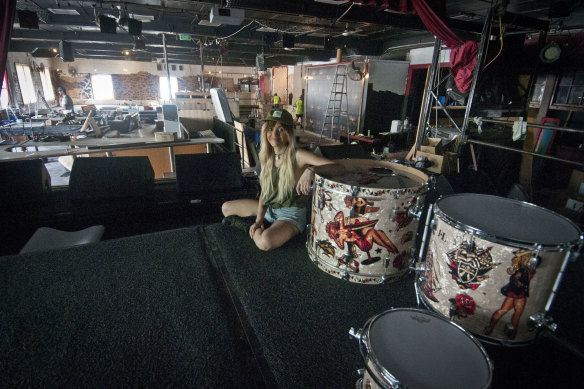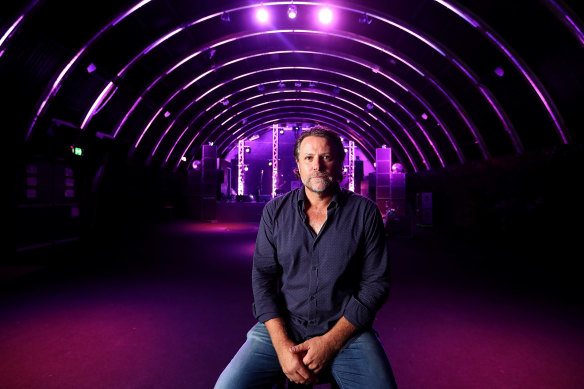- Perspective
- National
- Queensland
- Live music
The Zoo’s demise is live music’s canary in the coalmine
Last week’s shock announcement that storied Brisbane live music venue The Zoo would close after 32 years should send a shiver down the spine of every music lover in this city.
It’s been well-known since the pandemic that venues were struggling, but to lose The Zoo? One of the busiest rooms in Brisbane? Surely not.

Former owner of The Zoo, Pixie Weyland, ahead of its reopening in 2017.Credit: Robert Shakespeare
But, here we are. And if it can happen to The Zoo, then no venue is safe.
The Zoo’s demise is a portent of an existential crisis – a real canary-in-a-coalmine moment – for venues and artists alike. And not many people will feel both sides of that coin more than John Collins.
Not only does “JC” run two music venues in the Valley – The Triffid and The Fortitude Music Hall – but he also formed one-fifth of Powderfinger, as the bassist for one of Brisbane’s most successful bands.
“It’s weird at the moment,” he says.
“The industry seems like it’s a tale of two halves – like one half’s doing really well and the other half is really struggling.

John ‘JC’ Collins at the Triffid.Credit: Chris Hyde
“You look at arenas and stadiums – and I think the Fortitude probably in that better half – then there’s what’s going on with the smaller venues.”
What’s going on in those smaller venues fills JC with dread, both as a venue operator and a fan of the local live music scene. While the larger venues have the economy of scale to more easily afford necessities, such as security, JC says he fears for smaller rooms.
The flow-on effect of that? Up-and-coming bands – like Powderfinger was in the 1990s – will lose their pathway to success.
The Zoo was (and still will be, for a couple of months at least) a vital stepping stone between small local bars and the larger rooms in Brisbane – think The Triffid, Princess Theatre and The Tivoli.
It mostly comes down to economics, and changing spending habits as a perfect storm of skyrocketing rents, higher interest rates and myriad other cost-of-living pressures.
Those most likely to feel the squeeze? Live music’s target demographic – young people, mostly in their 20s, and mostly unencumbered by family commitments.
The Zoo’s owner, Shane Chidgzey, has sympathy for those concert-goers not spending money over his bar, even if that was the venue’s main source of income.
It’s what he calls a “post-COVID hangover” – people are naturally more cautious nowadays when it comes to spending money.
“People want to have the big experiences because they were stuck inside so long, so they’re chasing the big artists to go and see – and that doesn’t leave a lot left over,” Chidgzey says.
“So you’ve got to choose to go and see your favourite artists internationally, or go and see up-and-coming artists. You might have enough money to buy a ticket, but you don’t have enough money for anything else.”
Making the local scene even more precarious is the way people tend to discover music in 2024. What’s happening on Spotify here isn’t that much different to what’s happening on Spotify in other countries.
When I was discovering Powderfinger, I was immersed in the local music ecosystem – the same ecosystem in which Bernard, JC and the boys were immersed.
“I was listening to Triple Z when I was a teenager to discover bands, or going to [record stores] Rocking Horse and Skinny’s to listen to a record and buy it,” Collins says.
“Look, you can’t blame young people, it’s just a different market. It’s just what it is, and it’s hard to understand how to capture it.”
To get a better understanding of the situation, I spoke with someone who thinks about this stuff for a living – Dr Ben Green, a cultural sociologist at Griffith University.
Green agrees with JC.
“One of the spaces we see that reflected is in the Australian charts, which have an historic lack of Australian artists in the top 50,” he says.
“We can look at what was something of a success story in the 1990s, when you had a national youth broadcaster spread across the land with Triple J, hand-in-hand with the rise of these all-ages music festivals and, of course, you’ve got the TV, you’ve got Recovery [which aired Saturday mornings on the ABC].”
What a time that was. And nowhere was the strength of the Australian music industry on display as much as in Brisbane.
“People talk about the ‘Big Four’ – Powderfinger, Custard, Regurgitator and Screamfeeder,” Green says.
“Well, they came from the local scene, but the way they turned into national figures was through that media and through those festivals.
“That is what’s missing now.”
So what can be done? Last week, Chidgzey suggested a levy on major international acts – a dollar or two on top of the already hefty ticket price – which could be poured into the local scene.
Green says there’s merit in that approach, along with other regulatory levers governments could pull. An underwritten live music insurance scheme, for starters (The Zoo’s insurance bill went from $35,000 to $65,000 in two years), and a music venue trust – something that has had some success in the UK.
“There are ways of protecting venues because we recognise, OK, it’s in the public interest that we have these spaces, but as a pure capitalist venture, they’ve got issues,” he says.
“Because they’re a public good, how can we publicly support them for the good of society?”
As for getting local music into the ears of young people, Green says it’s time multinational streaming services pulled their weight.
“Streaming platforms aren’t neutral – they can promote and highlight certain things, they can promote certain playlists – so there are ways that they could be obliged in national markets, to have the equivalent of a local content quota,” he says.
Certainly worth a listen.
So, if you can, get to a local gig. Climb up those Zoo stairs for one last time, to see it off in style. Hell, if you have enough money to burn, buy the joint!
But, as Chidgzey said last week, that model has got to change.
Brisbane City Council worked with the state government to get the Valley Special Entertainment Precinct off the ground, ostensibly to protect the live music scene from complaining neighbours (but, in reality, mostly protecting doof-doof playing megaclubs).
Surely they can do it again and find a solution so the next Saints, Go-Betweens, Powderfinger, Violent Soho or Jungle Giants can navigate their own pathway to national and international success.
The show simply must go on.